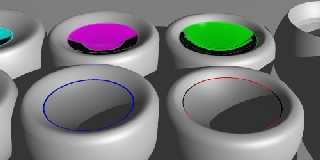|
 |
JC (Exether) nous apporta ses lumieres ainsi en ce 2004-12-14 10:03... :
> Hi,
>
> For my PovComp WIP, I'm trying to use blobs as liquid containers. I
> have made a little scene to illustrate the problem I have.
> In this scene you see eight containers, on the right are two CSG
> containers to check if the problem appears. On the left you have 3
> series of blob container from deep on the right to shallow on the left.
> They are all filled with liquid, first plane, the containers are
> filled with a semi sphere that is a little bigger than the hole (which
> is what I would like to do) and second plane, the liquid is
> 'differenced' to be a little bit smaller than the hole.
>
> As you can see all the first plane blob containers have a line
> appearing at the contact between the liquid's surface and the
> container. And this line gets thicker as the slope is less steep.
>
> Is this a bug ? Is it something I made wrong (I made the code
> available) ? Is there any way to avoid it ?
>
> Thanks for your help,
>
> JC
>
> ------------------------------------------------------------------------
>
>
>------------------------------------------------------------------------
>
>// Persistence of Vision Ray Tracer Scene Description File
>// File: ?.pov
>// Vers: 3.5
>// Desc: Radiosity Scene Template
>// Date: mm/dd/yy
>// Auth: ?
>//
>
>#version 3.5;
>
>#declare Radiosity=on;
>
>global_settings {
> assumed_gamma 1.5
> #if (Radiosity)
> radiosity {
> pretrace_start 0.08
> pretrace_end 0.01
> count 50
> nearest_count 5
> error_bound 0.9
> }
> #end
>}
>
>#default {
> texture {
> pigment {rgb 1}
> #if (Radiosity)
> finish {
> ambient 0.0
> diffuse 0.6
> specular 0.3
> }
> #else
> finish {
> ambient 0.1
> diffuse 0.6
> specular 0.3
> }
> #end
> }
>}
>
>// ----------------------------------------
>
>camera {
> right x*image_width/image_height
> location <0,3,-4>
> look_at <0,1,0>
> angle 55
>}
>
>light_source {
> <40,30,-45> // light's position
> color rgb <1, 1, 1> // light's color
>}
>
>// ----------------------------------------
>
>plane { y, 0 }
>plane { y, -10 }
>
>#declare M_Water= material {
> texture{
> #declare SC=1/255;
> pigment{rgbt <SC*57, SC*63, SC*66, 0.9>}
> finish{ambient 0 diffuse 0.3 reflection {0,1 fresnel on} conserve_energy
specular 0.4 roughness 0.003 }
> }
> interior{
> ior 1.34
> fade_distance 1
> fade_power 1001
> fade_color rgbt <SC*37, SC*63, SC*45, 0.7>
> }
>}
>
>// create a smooth blobby shape
>#declare RadiusVal = 1.0; // (0 < RadiusVal) outer sphere of influence on other
components
>#declare StrengthVal = 1.0; // (+ or -) strength of component's radiating density
>
>#macro BBassin (thr, flat)
>blob {
> threshold thr
> sphere { y, RadiusVal, StrengthVal }
> sphere { <0,1.5*flat,0>, RadiusVal*0.7*flat, -StrengthVal }
> sphere { <0,1.2*flat,0>, RadiusVal*0.5*flat, -StrengthVal }
>}
>#end
>
>#local SBassin1 = difference {
> sphere { <0,1,0>, 0.6 }
> sphere { <0,1.5,0>, 0.5 }
> sphere { <0,1.2,0>, 0.4 }
>}
>#local SBassin2 = difference {
> sphere { <0,1,0>, 0.59 }
> sphere { <0,1.5,0>, 0.49 }
> sphere { <0,1.2,0>, 0.4 }
>}
>
>
>#declare Water = intersection {
> sphere { <0,1.15,0>, 0.5 }
> cylinder { <0,0.7,0>, <0,1.15,0>, 0.51 }
>}
>
>#local e=0.6;
>union {
> object { BBassin (0.4, 1.0) }
> object { Water material { M_Water } }
> translate <e,0,-e>
>}
>union {
> object { BBassin (0.4, 1.0) }
> difference { object { Water } object { BBassin (0.39,1.0) } material { M_Water } }
> translate <e,0,e>
>}
>union {
> object { BBassin (0.4, 1.1) }
> object { Water material { M_Water } }
> translate <-e,0,-e>
>}
>union {
> object { BBassin (0.4, 1.1) }
> difference { object { Water } object { BBassin (0.39,1.1) } material { M_Water } }
> translate <-e,0,e>
>}
>union {
> object { BBassin (0.4, 1.2) }
> object { Water material { M_Water } }
> translate <-3*e,0,-e>
>}
>union {
> object { BBassin (0.4, 1.2) }
> difference { object { Water } object { BBassin (0.39,1.2) } material { M_Water } }
> translate <-3*e,0,e>
>}
>union {
> object { SBassin1 }
> object { Water material { M_Water } }
> translate <3*e,0,-e>
>}
>union {
> object { SBassin1 }
> difference { object { Water } object { SBassin2 } material { M_Water } }
> translate <3*e,0,e>
>}
>
>
>
You've been hit by a bad case of
ray-misses-the-intersection-between-two-surfaces-and-hit-what's-behind!
Adding a different interior_textures to each examples give me 6
differently coloured areas where you have black.
My render (raised the camera a bit, no radiosity, interior with ambient 1):
Alain
Post a reply to this message
Attachments:
Download 'essai_fringe.png' (86 KB)
Preview of image 'essai_fringe.png'

|
 |




![]()